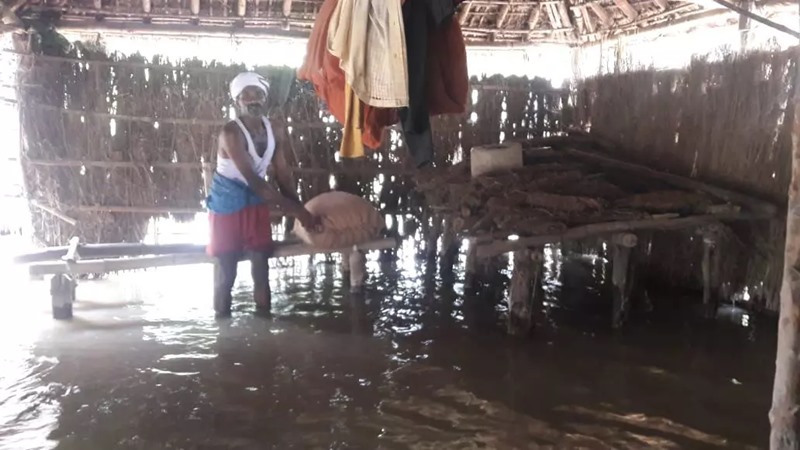Bihar Floods 2021: A month on, flood and fury continue to lash Bihar
Thousands of people in Bihar are stranded without food, shelter or clean drinking water; cremations are being conducted from boats, and people have to climb trees to relieve themselves. The Kosi and Gadak rivers continue to wreak havoc in the state.


Floodwaters have inundated the landscape, and as far as the eye can see there is not a patch of dry land anywhere. All photos: Rahul Jha
Supaul, Bihar
There is pandemonium in the districts of north Bihar that lie on the India-Nepal border. Hundreds of thousand people are trying to escape from swollen rivers, and move towards drier and higher elevations, carrying their children, ailing elders and cattle along.
Floodwaters have inundated the landscape, and as far as the eye can see there is not a patch of dry land anywhere. In Bihar, India’s most flood-prone state, the annual ritual of disaster, displacement, destruction and death is playing out. Yet again.
Unimaginable as it may be, cremations are being carried out from boats. “The crematorium in the village is submerged. So, we had to build a platform of bamboo that was pegged firmly to the ground. A mud enclosure was placed on top of it, into which the body was laid, and the family members lit the ‘pyre’ standing in boats close by,” Nunnu Laal from Darbhanga district, who participated in the ritual, told Gaon Connection. In some other places, cremations are happening wherever people found dry land.
Over 180 kilometres away, at Ghoda Ghat in Araria district, things are as miserable. “If we have to answer nature’s call we have to climb up trees to do so. There is no place to defecate,” Abdul Khadus, a local villager, told Gaon Connection. The women and young girls are particularly affected, he added.
It’s been weeks and there has been no let up in the fury of floods in Bihar with over 800,000 people in 15 districts affected severely. Hundreds of villages are marooned, homes and toilets are broken, and there is an acute shortage of safe drinking water and food being reported from the flood-hit areas.

“It takes us a lifetime and all our savings to build our home and it took Kosi [river] just a second to bring it crashing down,” Asha Devi from Manatola village in Supaul district of Bihar, sobbed. In her village, there is no fodder left to feed cattle, countless homes have collapsed in the flood waters, and if the flooding continues, there will be nothing left of Manatola, said its inhabitants.
Also Read: Marooned for a month, villagers in Bihar have no access to sufficient food, healthcare, toilets
Early monsoon and its fury
The floods are nothing new to Bihar, but no one was expecting the monsoon to arrive quite so early and be so furious. Excessive rains have lashed the state since last month and the swollen rivers – Kosi, Gandak, Burdhi Gandak and others — have submerged hundreds of villages in their path since the second week of June.
According to the India Meteorological Department (IMD), of the 38 districts in Bihar, three have recorded ‘large excess’ rainfall whereas 15 have recorded ‘excess’ rainfall in this southwest monsoon season, between June 1 to July 23.
West Champaran district has seen nearly 146 per cent above its normal rainfall (large excess rainfall category). In East Champaran, the rainfall has been 25 per cent above normal, Supaul 55 per cent more, Madhubani 66 per cent more (large, excess) and Darbhanga 89 (large excess).
“The flood happened twenty days earlier,” Ram Lochan from Bauraha panchayat, in Supaul district, told Gaon Connection. “Every year the government gives dalmoth and biscuits to tide us over, but this time we have received neither the rations nor any officials to find out how we are faring,” the 48-year-old Lochan added. Nearly a hundred villages in the vicinity of the Kosi Dam are inundated since June 24, said Lochan.
“Here we are struggling to even eat once a day, and the administration seems to be totally oblivious to our distress,” 68-year-old Ram Prasad Sah, from Maujha panchayat in Supaul district, told Gaon Connection.
A joint survey report titled Joint Rapid Needs Assessment, Bihar Floods, 2021, was released on July 13, by Bihar Inter Agency Group, a regional coalition of Humanitarian/UN agencies working in Bihar’s state capital Patna, and Sphere India, a national coalition of humanitarian agencies based out of Delhi.
According to the survey, carried out in three of Bihar’s most flood affected districts, West Champaran, East Champaran and Muzaffarpur, 90 per cent of the flood affected respondents said they had no safe drinking water and half the toilets were broken. A large chunk of people lost their crops, cattle and homes.
People in north Bihar are worried because there are still two more months before the monsoon recedes.

Land erosion and loss of houses
The rivers Kosi and Gandak, along with the many other rivers and their small tributaries that flow from them, have created havoc in Supaul, West Champaran, East Champaran, Muzaffarpur, Saharsa, Arariya, Madhepura and Darbhanga.
Not just flooding, the Kosi river is notorious for severe erosion. Her banks are eroding rapidly and causing further damage to the villages. In Saharsa district, in four villages in Kedli panchayat, Nauhatta block — Paharpur, Rampur, Chatwan and Asai — of the 500 families living there, nearly 100 have lost their homes due to the erosion caused by Kosi.
Village inhabitants say that if the erosion continues, there will be nothing left standing.
“We are like nomads and this is nothing new to us. The land beneath our home has been eroded and we are moving to a higher place with whatever we can salvage,” Arvind Yadav, from Asai village told Gaon Connection.
Echoing what Yadav said, Uday Chaudhury, the pradhan of the Bauraha panchayat added, “The people in villages near the river banks have to shift every year, from their flooded homes to pavements. The settlements you see on roadsides are proof of this,” Chaudhury told Gaon Connection.
“This is just the beginning. The washing away of homes and the erosion will continue for a long time now,” Dinesh Chandra Mishra, a scholar who has worked on flooding in Bihar and on the Kosi river particularly for years, told Gaon Connection.
“It has been observed that once the waters of the Kosi recede, the erosion will speed up,” he said. According to Mishra, when the flood waters start receding by mid-September, the erosion of the river banks will increase and hundreds more will lose their homes.

Government’s response
The state government claims it is doing the needful and responding to the floods. Twenty eight community kitchens have been set up in the flood affected areas. The web portal of the department of water resources, Flood Management Improvement Support System and the website of the department of disaster management, where updates on the flood situation are uploaded, all the river embankments in the state are declared safe.
Also Read: ‘We’re ready to die but won’t let an embankment be built on the Bagmati’
The reality is something quite different. On July 22, at approximately one am, the Sikarhata-Majhari embankment in Supaul district at the Dagmara panchayat gave way, flooding villages nearby.
“Claims of repair and reinforcement work, new constructions, relief from floods, etc., have been made for years,” Mahendra Yadav, an activist who has worked for the relief and compensation of flood victims in Bihar, told Gaon Connection.
“On June 15, last year, at the cost of eighty crore rupees, anti-erosion work was carried out at Birpur in Supaul district, on Kosi river’s west bank,” he added. According to him, it was claimed that the bank could withstand the pressure of 900,000 cusecs of water. However, when just 200,000 cusec water was discharged, the bank was unable to counter the fury of the river, he said. “If the work had been carried out properly, why would the embankments give way,” Yadav asked.

While villagers have suffered huge losses in the floods this year, they allege they are yet to receive compensation for losses suffered in the past couple of years.
There is a provision of compensation of Rs 6,000 per flood-affected family. However, in Kishanpur block in Supaul district, 1,050 flood affected families have got no compensation so far.
“We have received no flood compensation after 2017. We are tired of visiting the circle office. Nothing has come of it,” Sita Devi of Parsahi village in Kishanpur block in Supaul, told Gaon Connection.
“We stay awake nights worrying about snakes and scorpions. And despite being surrounded by water, we have no water to drink,” Rama Devi of Kishanpur village in Supaul, summed up the miserable condition of the flood-affected people.
Read the story in Hindi.

